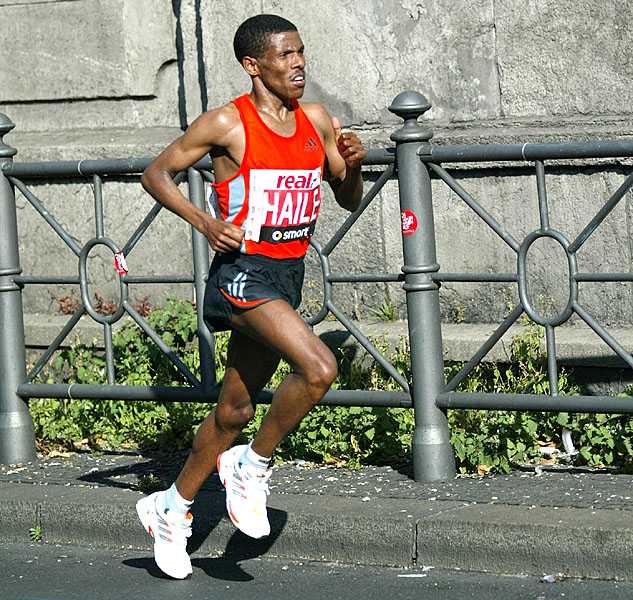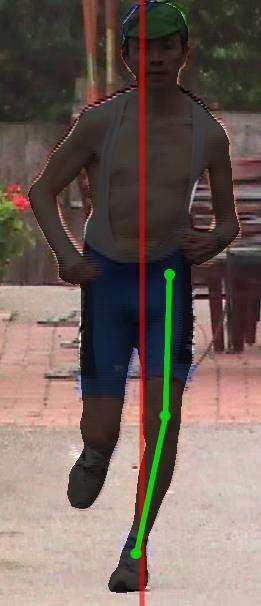running form analysis @ Innersport
At the recommendation of my friend Nathan, I went to Innersport to get my running form analyzed. I felt my form was fairly good, but I'd been suffering pain around my left knee when I became fatigued. Maybe my self-perception of my form wasn't so good...
The results were really striking. Let's start with the side view. First, the model: Danny Dreyer, from Chi Running:

Not obviously this is slightly artificial since the foot alignment changes during the stride, so the frame was chosen carefully. But in general you can see the body is aligned, as though standing, but tilted forward from the foot.
Now look at my position, taken at a somewhat arbitrary position in my stride. I captured the frame myself with Gimp, then did the annotation there (don't blame Dr. Jess for this):

I'm bent forward at the hip. Sure, a different frame might show a different angle, but it's clear this degree of bend isn't an artifact of phase. I'm taking my cycling position to running. Not good.
Here's a view of a real runner, with a random frame not chosen to promote a particular running style:

Even here, the runner looks aligned: no indication of a bend at the waist.
But it gets even worse. Look at my front view:

Ouch! That hurts just looking at it. Can you say "maximal torque?" The left knee is too far out, and the foot crosses the center-line. When my right foot is on the ground it's a bit better, not crossing the center line but still not aligned. Here's how that real runner looks:

Look at that: knee further in, tibia vertical.
I posted before on my running form. Here's an image from the Quimby Low-Key Hillclimb in 2008.

 I'm on the right. Trail running legend Gary Gellin is on the left. At the time I was interested in foot strike (the green circles), but there's that knee problem staring me in the face. Look at that bend in my left knee! I don't know how I managed to run through February 2009 before suffering any issues that winter. Finally, at the Woodside Half, I began getting pain.
I'm on the right. Trail running legend Gary Gellin is on the left. At the time I was interested in foot strike (the green circles), but there's that knee problem staring me in the face. Look at that bend in my left knee! I don't know how I managed to run through February 2009 before suffering any issues that winter. Finally, at the Woodside Half, I began getting pain.
Anyway, it's clear what I need to do to improve my form. And it's easy enough to get photoed from the front and side to see if I've succeeded.
The results were really striking. Let's start with the side view. First, the model: Danny Dreyer, from Chi Running:

Not obviously this is slightly artificial since the foot alignment changes during the stride, so the frame was chosen carefully. But in general you can see the body is aligned, as though standing, but tilted forward from the foot.
Now look at my position, taken at a somewhat arbitrary position in my stride. I captured the frame myself with Gimp, then did the annotation there (don't blame Dr. Jess for this):

I'm bent forward at the hip. Sure, a different frame might show a different angle, but it's clear this degree of bend isn't an artifact of phase. I'm taking my cycling position to running. Not good.
Here's a view of a real runner, with a random frame not chosen to promote a particular running style:

Even here, the runner looks aligned: no indication of a bend at the waist.
But it gets even worse. Look at my front view:

Ouch! That hurts just looking at it. Can you say "maximal torque?" The left knee is too far out, and the foot crosses the center-line. When my right foot is on the ground it's a bit better, not crossing the center line but still not aligned. Here's how that real runner looks:

Look at that: knee further in, tibia vertical.
I posted before on my running form. Here's an image from the Quimby Low-Key Hillclimb in 2008.

 I'm on the right. Trail running legend Gary Gellin is on the left. At the time I was interested in foot strike (the green circles), but there's that knee problem staring me in the face. Look at that bend in my left knee! I don't know how I managed to run through February 2009 before suffering any issues that winter. Finally, at the Woodside Half, I began getting pain.
I'm on the right. Trail running legend Gary Gellin is on the left. At the time I was interested in foot strike (the green circles), but there's that knee problem staring me in the face. Look at that bend in my left knee! I don't know how I managed to run through February 2009 before suffering any issues that winter. Finally, at the Woodside Half, I began getting pain.Anyway, it's clear what I need to do to improve my form. And it's easy enough to get photoed from the front and side to see if I've succeeded.

Comments
You strike the ground with your foot in a heavily supinated position which and the rest of your lower anatomy compensates. I am guessing that if you look at your running shoes the wear is at the outer edge.
The heels are definitely more worn on the outside edge than the inner edge, although curiously this is a bit more the case for my right shoe than my left, and the left had the more sever angle.
I shim my right foot on the bike (at the recommendation of Curtis Crumblett) by 1 mm or so (cut out of a milk jug). I've not used wedges. There's the test where you do a one-legged squat and see how your knee tracks. My left knee tracks true, while my right knee tends to move in.
So I'll try to follow up on my bike foot position. I was planning on getting Bont shoes, so it's a chance to take a fresh look at my cycling form.
On the running side: I've been focusing on improving my stride form, and I think it's helping. It got me through the Pirates Cove 30 km trail run today, although my left leg still complains, especially on descents.
1. Land with my feet below my center of gravity.
2. Think of running as controlled falling.